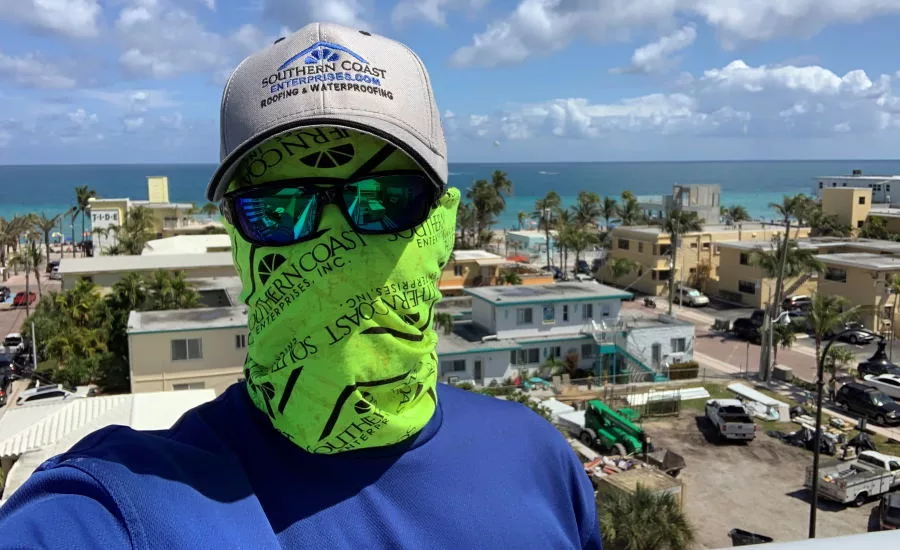How Roofing Contractors Are Protecting Themselves from the Heat During the COVID-19 Pandemic

A roofing contractor with Southern Coast Enterprises in Florida shows off their custom face mask while working. Photo courtesy of Southern Coast Enterprises.
Working on top of a roof is already hard work, but roofing contractors around the country are now contending with oppressive heat waves in addition to the stresses caused by the COVID-19 pandemic.
The South in particular is expected see temperatures peak above 110 degrees starting this weekend. The National Weather Service said as of today, more than 70 million people are under excessive heat watches, warnings and advisories, and predicts this heat wave won’t stay in the South. Instead, it will make its way north and east to scorch the Ohio Valley and Mid-Atlantic with 100-degree temperatures.
Paired with the fact that multiple states saw sharp increases in COVID-19 cases, including a record single-day spike of 60,000 new cases in the U.S. on Tuesday, roofing contractors find themselves stuck between a rock and a hard place for keeping their crews safe.
“You can’t really make the guys that are working on the roof wear masks because it’s so hot outside, and they’re drenched in sweat and they’re already breathing hard,” said Will Miller, owner of Priority Roofing in Dallas. “It’s like putting a mask on a marathon runner — that can make them pass out more than anything.”
Heat vs. COVID-19 Protection
When it comes to practical advice for protecting workers during high heat, the Occupational Safety and Health Administration (OSHA) suggests the following:
- Water, rest, shade. Workers should drink water every 15 minutes and take frequent rest breaks in shaded or air-conditioned areas.
- Check the heat index. A rule of thumb is that workers need extra protection when the heat index is 80 degrees Fahrenheit or above.
- Know the symptoms. Symptoms of heat-related illnesses include fatigue, thirst, heavy sweating, slurred speech, dizziness, nausea, unconsciousness and seizures.
The issue roofing contractors are running into stems from trying to adhere to these practices while protecting against COVID-19 with face masks. In some states, wearing a mask is mandatory to help prevent the spread of the virus. Mandatory face coverings can be anything from a bandana to a cloth mask, though contractors can also utilize personal protective equipment (PPE) like N95 masks and respirators.
Trent Cotney, CEO of Cotney Construction Law, said his offices have experienced a notable increase in calls related to heat illness. Around this time, they receive about one or two of these calls in a week. In the first week of July, they received 11 calls.
“What we surmised…is that these places that require mandatory masks, there’s a lot of crew people that are wearing these masks, and they may not be the proper types of masks, they may not be breathable,” Cotney said. “They’re increasing the ambient heat that is blowing back in your face.”
Studies have shown that, even when wearing PPE like an N95 mask, people experienced raised body temperatures and feel warmer.
COVID-19 is also hampering water intake, as contractors are hesitant to frequently remove face masks to take a drink. Some employers are even eliminating communal aspects like water stations to maintain social distancing.
This puts contractors in a tough bind, forcing them to choose between protecting against the heat versus COVID-19. Cotney said the best thing to do is to be as compliant as feasibly possible on both fronts, but definitely mandate water breaks.
“I recognize heat as a killer, it is an absolute killer where we see roofing contractors do work, or any contractor, so I would always err on the side of making sure you’re properly hydrated,” Cotney said, adding that contractors should still wear masks and practice social distancing when able.
To make matters worse, the Centers for Disease Control and Prevention states that social distancing and wearing a mask makes it more difficult to recognize heat-related illness symptoms when implementing the “buddy system.” Instead, workers are encouraged to ask one another how they’re feeling during the workday.
Miller said his company allows up to three hours of rest time during excessive heat days so they can hydrate and recover, but is also encouraging social distancing where appropriate.
“It’s letting them work at their own pace — we aren’t going to slave drive them, we aren’t going to push them,” he said. “We want everyone to feel comfortable, we want everyone to feel safe. Whatever their level of comfort is, we’re not going to push you beyond that.”
Heat Hazard Citations
The General Duty Clause of the OSHA Act of 1970 states employers must provide a place of employment for its employees “free of recognized hazards that are causing or likely to cause death or serious physical harm.” OSHA has no specific standard for governing heat-related hazards, so it uses the clause to cite contractors for heat-related hazards.
In a bulletin from Gary Auman of Auman, Mahan & Furry, he describes a case in 2012 where OSHA cited Sturgill Roofing in Ohio for not having a heat illness prevention program following the death of a temporary worker. He said the Occupational Safety and Health Review Commission published its decision on the case in February 2019, deciding 2-1 to overturn a decision affirming the citation.
“I feel that the OSHRC is using the Sturgill decision to put OSHA on notice of the Review Commission’s concerns with OSHA’s overuse (and perhaps improper use) of the General Duty Clause as an enforcement tool in many different situations, including but not limited to heat illness prevention,” Auman wrote.
Despite this, he said contractors can still expect OSHA to cite employers for failing to protect employees from heat-related illnesses. To mitigate this, roofing contractors should at a minimum have in place heat-hazard training and a heat illness prevention program.
“One thing the Sturgill case did for employers is to require OSHA to specifically identify the heat illness hazard on any jobsite, to demonstrate that the employer’s heat illness prevention program is not effective to prevent heat illness,” Auman said.
Looking for a reprint of this article?
From high-res PDFs to custom plaques, order your copy today!








